
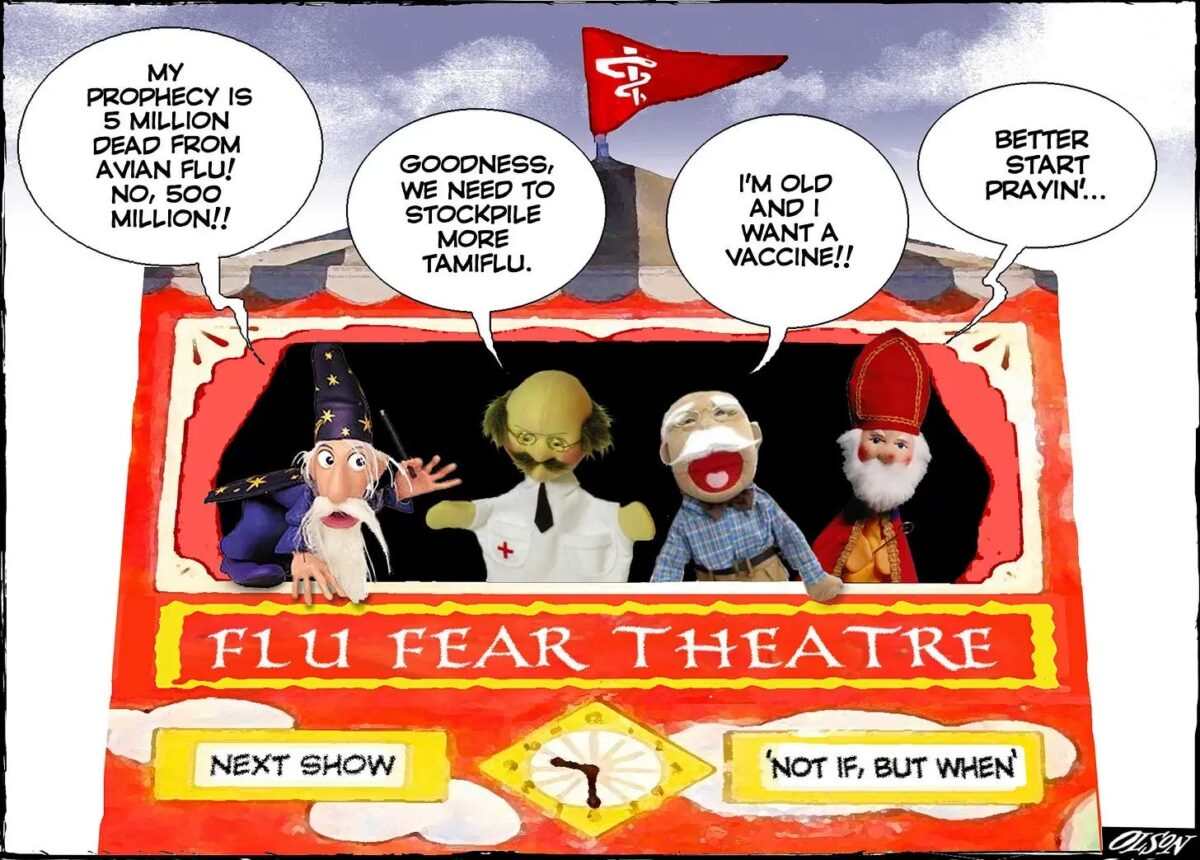
Avian Flu: Everything Old is New Again
by Geoff Olson | Dec 01, 2024
Feeling nostalgic for everything from the early aughts? Stuff like Wii consoles, mobile flip phones, Baby Elmo, and bands like Nickelback and Limp Bizket? Speaking of limp, how about the era’s much-ballyooed threat from avian flu, which failed miserably to scale up into global pandemic?
I’m not going to focus here on recent claims from the usual health policy suspects about the current human threat from avian flu. That’s for you to read, decode and decide. Instead, I’m going to take you back to media reports on the selfsame infectious disease dating two decades back. Just for comparison’s sake.
No, thank you.
Things first got rolling in 2005, when legacy media tuned into an infectious disease among domesticated fowl. The Guardian reported that “a global influenza pandemic is imminent and will kill up to 150 million people, the UN official in charge of coordinating the worldwide response to an outbreak has warned.”
That sounded like a pretty definitive figure for animal virus that hadn’t – and still hasn’t — been associated with widespread human outbreaks.
Just two paragraphs later the figure becomes more rubbery, with The Guardian adding that the cited expert, David Navarro, “told the BBC that the “range of deaths could be anything between five and 150 million”.”
More dramatically, a few more paragraphs down, Neil Ferguson, a professor of mathematical biology at Imperial College London – who later became infamous for his wild overestimates for Covid deaths – insists that up to 200 million people could be knocked off by bird flu.
“Around 40 million people died in 1918 Spanish flu outbreak,” said Prof. Ferguson. “There are six times more people on the planet now so you could scale it up to around 200 million people probably.”
Wow. 5 to 150 to 200 million in the space of a few paragraphs. At that Andromeda Strain growth rate, every reader of that issue of The Guardian should have been dead as a doornail by the sports page.
Not surprisingly in retrospect, the hysteria over avian flu was common in legacy media at the time.
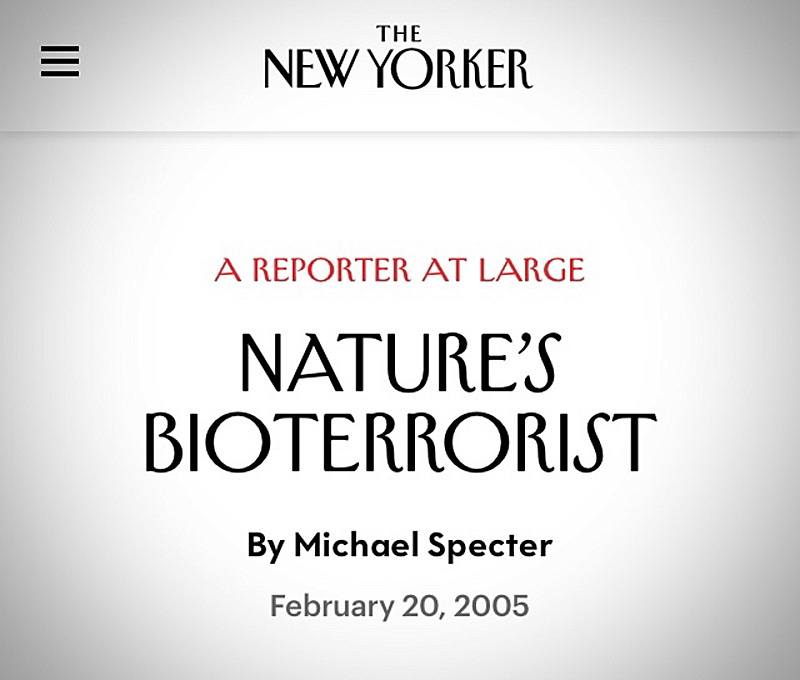

Yet not all the mainstream reporting was quite this bird-brained. At least, not at first. “Despite all the hysteria, there isn’t a shred of evidence that a pandemic is actually on the way,” wrote Wendy Orent in an October 16, 2005 report for The Washington Post, titled “The Fear Contagion”:
Another dangerous idea for pandemic preparation has come from President Bush. Earlier this month, he suggested using the military to enforce a quarantine. “Who [is] best to be able to effect a quarantine?” he asked rhetorically at a press conference. “One option is the use of a military that’s able to plan and move.”
But he isn’t the only one talking about quarantines and calling in the troops. In an Oct. 5 interview on “The NewsHour With Jim Lehrer,” Julie Gerberding, director of the Centers for Disease Control and Prevention, also wondered whether the government would need to turn to “containment” or “quarantine the people who are exposed.” She too remarked that the military or the National Guard might be summoned “to maintain civil order, in the context of scarce resources or an overwhelming epidemic. . . . It would be foolish not to at least consider it and plan for that as a possibility.”
However, The Washington Post reporter did endorse the development of a vaccine, just in case.
Here was my own take of the situation at the time…

Vancouver Courier cartoon, 2005
In December of 2005, Congress passed bio-defense legislation as part of a Department of Defense appropriations bill, which provided funds “to prepare for and respond to an influenza pandemic, including the development and purchase of vaccines, antivirals, and necessary medical supplies, and for planning activities.”
These appropriations allowed the federal government to procure and stockpile vaccines in the event of a bird flu pandemic. However, provisions were later added to the bill after a House-Senate conference committee, which offered drug manufacturers “targeted liability protection,” even though House Republicans had earlier promised that there would be no liability protections included in the legislation. Leading Senate Democrats alleged that then-Senate Majority Leader Bill Frist and others “cut a back room deal” at the last minute to give massive liability protections to drug companies.
These immunity provisions, collectively called the Prep Act, provide immunity from lawsuits for any manufacturer, distributor or administrator of a “covered countermeasure”—drugs, vaccines or other medical devices—used to protect Americans in the event of a pandemic, epidemic, or biological attack.
– Rethinking Liability for Vaccine Injury, Joanna B. Apolinsky* and Jeffrey A. Van Detta, Cornell Journal of Law and Public Policy
Music of the Spheres
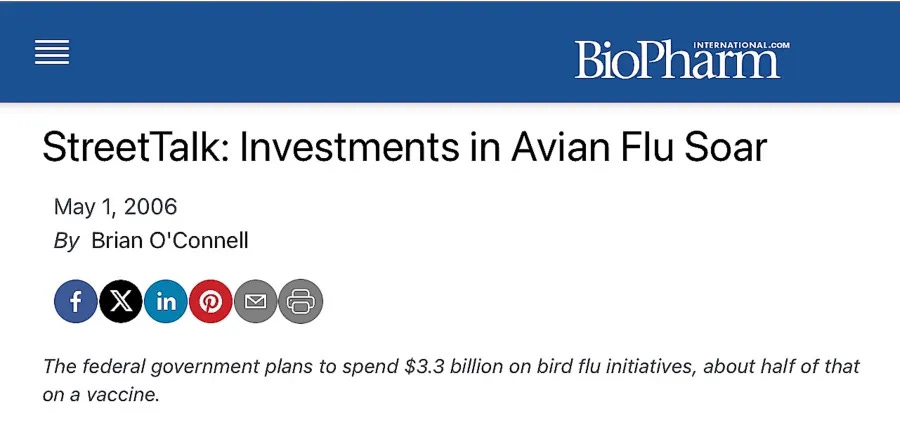
Cue the music of the sphere, aka the ring of cash registers. On May 1, 2006, Brian O’Connell, a business/finance commentator for CNN and Fox News, penned this giddy piece for BioPharmInternational.com:
You can’t swing a dead yellow-bellied sapsucker without running into an investment speculator whooping it up over the impending bird flu bonanza. Sure, there’s been a big potful of money earmarked for avian bird flu vaccines, both public and private. In March, Health and Human Services Secretary Michael Leavitt announced that the federal government plans to spend $3.3 billion on bird flu initiatives, about half of that on a vaccine.
….
Novavax, the flu vaccine manufacturer based in Malvern, Pa., saw its stock climb to a 52-week high last October after media reports that the bird flu epidemic had escalated in countries like Turkey, Rumania, and Russia; and even Great Britain (where a lone parrot shipped from South Africa was found to have the disease).
BioCryst Pharmaceuticals of Birmingham, Ala., which had a now-disbanded partnership with Johnson & Johnson to develop a vaccine, also saw its stock fly to new heights, hitting a five-year high of $18.42 a share in October on the same news that drove up Novavax’s stock.
One of my favorite economists, Donald Luskin, has written a great deal on the investment opportunities in bird flu vaccines. As Luskin—and many scientists—points out, if the H5N1 virus makes the expected jump from birds to humans, a pandemic could follow.
When it comes to new products and services, you never know if the market’s ‘invisible hand’ is going to present a high-five or the finger. Yet in this case, the smart money was on the former.
“There are so many unknowns and a lot of hype,” said A.G. Edwards analyst Al Goldman in an interview with the Associated Press in December 2005. “The avian flu potential is something that you can’t get your arms around because no one knows if—or when—a pandemic is going to happen.”
The truth is, a pandemic is already brewing on Wall Street. When there’s money to be made, it’s always wise to watch the birdy.
– Brian O’Connell, “Street Talk: Investments in Avian Flu Soar,” BiopharmInternational, 2005
You can’t have profits without a serious scare, of course. On July 21, 2006, the CBC aired the Fifth Estate documentary “Black Dawn,” which took a suitably Canuck bent on the apocalyptic threat from avian flu: “WHAT IF WE HAD TO STORE OUR DEAD IN ICE RINKS?” (Jezus Lord, don’t let our hockey games fall at risk!)


As it turned out, there was a total of 279 reported deaths worldwide from the disease between 2003 and 2009. (Insert sound of a deflating balloon or whoopee cushion here). And after all that diligent pecking by the laptop warriors of the press!

By May 12, 2008, a less plague-promoting CBC inserted a question mark into a report entitled, “The Next Pandemic?” It noted HN51 was one of the 16 varieties of avian influenza or bird flu, and “so far, the only one that’s shown any ability to directly pass from one human to another…but it wasn’t the dangerous variety of the disease.” However, a deadly form of H5NI, much less transmittable, had been found to have “spit into two distinct strains, a development that could make it harder to develop vaccines to stop the spread of the disease.”
Obviously avian flu merited continuted monitoring. Perhaps culls of domesticated fowl were preventing a real-world infectious disease from going full Hollywood dystopic, but in any case if a real-world disaster movie was on the way, it required the making of scary trailers.

Macleans cartoon, 2005
Bird flu voodoo
This brings me to one of the central oddities of this decades-long story. As I wrote back in a 2012 column for The Vancouver Courier:
As of November, 2011, the dangerous form of H5N1 had reportedly infected only 571 people across the world, because its basic reproductive rate is very low, yet killed 335 because of its lethality. In its current state, it is much less deadly on a global scale than the common flu, a mild microbe which kills thousands yearly through high transmission rates. Yet recently, scientists have found a way to mutate the H5N1 virus so it is just as transmissible between humans as the seasonal flu virus.
Alert the Nobel committee!
At a September conference on influenza in Malta, Dr. Ron Fouchier from the Erasmus Medical Center in Rotterdam proudly announced he and his team “mutated the hell out of the virus.” According to a December report in Wired magazine, Fouchier said initially the virus wasn’t spreading airbore among laboratory ferrets. And that was when “someone finally convinced me to do something really, really stupid” with his test animals, Fouchier added. With a bit more tinkering, he got the virus airborne and ready for publish-or-perish prime time.
“It’s just a bad idea for scientists to turn a lethal virus into a lethal and highly contagious virus,” said Dr. Thomas Inglesby, a bioterrorism expert and director of the Center for Biosecurity of the University of Pittsburgh Medical Center. “And it’s a second bad idea for them to publish how they did it so others can copy it.” So far, no medical journal has agreed to publish the genome of the altered virus – although the precedent is there with the 2005 publication of the full sequence of the 1918 Spanish influenza virus.
According to a November report in NPR, Fouchier’s work is now under scrutiny by a committee called the National Science Advisory Board for Biosecurity (and hopefully the investigation includes his US funding stream). To call this sort of research Faustian doesn’t even begin to cover it.
On January 20, 2012, a moratorium was announced on research developing extra-contagious strains of H5N1 avian influenza. For a whopping sixty days. Cut to mid-2014. A group of scientists formed the Cambridge Working Group and issued a statement warning of the risk of further experimentation in this area. Hundreds of scientists from “every major U.S. and European university” signed the statement.
Cut to October 2014. the U.S. government called for a “pause” in this dangerous research. NIH Director Francis Collins said that his agency would study the risks and benefits before proceeding further.
Cut to 2019 — ain’t this like a Hollywood blockbuster? As reported in Science, US National Institute of health quietly allowed the research into weaponizing avian flu all over again. Yes, you read that right. Well, you know how this stuff works. You can’t let evolution get a jump on killing humanity, that’s the job of science.

History’s Book of Rhymes
“It has been said that history repeats itself. This is perhaps not quite correct; it merely rhymes.” – psychoanalyst Theodore Reik
According to Wikipedia, between 2003 and October 2024, there have been 464 confirmed deaths from H5N1 avian influenza out of 921 confirmed cases globally. Meaning the deaths had barely doubled since 2009.
Remember those near-term projections from The Guardian, way back in 2005: up to 200 million globally. So let’s see what we have here:
A warning beginning in 2005 that a global pandemic from avian flu was in the works, and soon. Check.
Projections of fifty million-plus dead. Check.
Trial balloons about quarantining the population, against their will if need be and with possible military enforcement. Check.
Excitement among investors about the profits from a new vaccine. Check.
Indemnification for Big Pharma against any potential vaccine harm. Check.
Gain of function experiments to supposedly weaponize the avian flu virus. In the public interest, of course.
Any of this sound vaguely familiar?
As for history “rhyming,” hopefully we’re not in for an especially dirty limerick that wasn’t that funny the first time around. In the meantime, let’s try to retain some healthy skepticism as things go FLUBAR all over again (FLU Bullshit Alarmist Reports). And when possible, with a bit of humour added to lift our sagging spirits….

Simplified rendition of the dynamic between revenue-hungry big media and ad-buying pharmaceutical giants with deep pockets



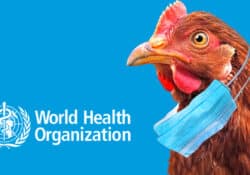
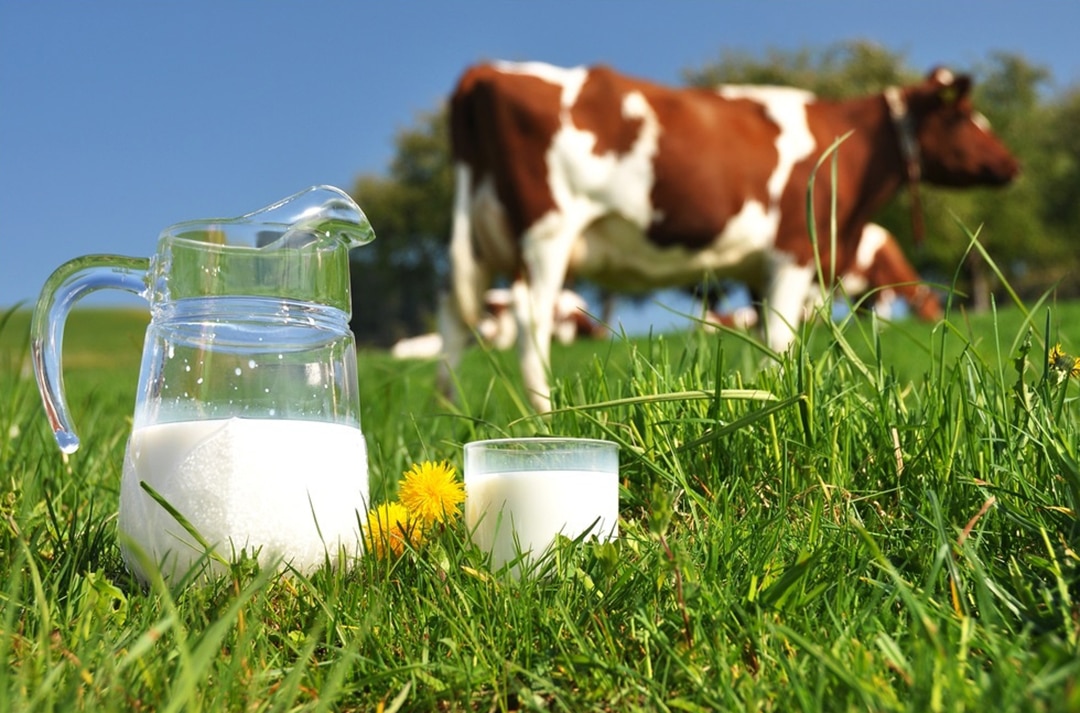
![[UPDATED] And the Bird Flu just keeps on coming… Bird Flu](https://zero-sum.org/wp-content/uploads/2024/05/The-bird-Flu-BW.jpg)
